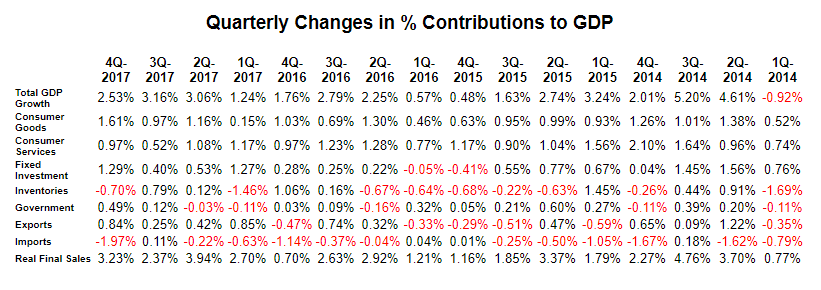BEA Leaves 4th Quarter 2017 GDP Growth Essentially Unchanged At 2.53%
In their second estimate of the US GDP for the fourth quarter of 2017, the Bureau of Economic Analysis (BEA) reported that the US economy was growing at a +2.53% annual rate, down -0.01% from their previous estimate and down -0.63% from the prior quarter.
This report contains no material revisions. The largest change consisted of the shifting of 0.15% growth from consumer goods spending to consumer services spending. Otherwise, no line item in the report changed by more than +/- 0.03%. The BEA's "bottom line" for the quarter (their "Real Final Sales of Domestic Product", which excludes inventories) increased slightly to +3.23%, up +0.02% from the previous estimate and +0.86% from the prior quarter.
Real annualized household disposable income improved +$12 per year from the previous report to $39,225 (in 2009 dollars). The household savings rate improved marginally to 2.7%, the same low level recorded in third quarter of 2007 -- at the onset of the "Great Recession."
For this revision, the BEA assumed an effective annualized deflator of 2.34%. During the same quarter (October 2017 through December 2017) the inflation recorded by the Bureau of Labor Statistics (BLS) in their CPI-U index was a very similar but slightly higher 2.49%. Underestimating inflation results in optimistic growth rates, and if the BEA's "nominal" data was deflated using CPI-U inflation information the headline growth number would have been slightly lower at a +2.44% annualized growth rate.
Among the notable items in the report :
-- The headline contribution from consumer expenditures for goods dropped to +1.61%, down -0.15% from the +1.76% previously reported (although still up +0.64% from the prior quarter).
-- The contribution to the headline from consumer spending on services exactly offset the revision to the consumer goods number, increasing +0.15% to +0.97%. The combined consumer contribution to the headline number remained at +2.58%, up a +1.09% from 3Q-2017.
-- The headline contribution from commercial private fixed investments was revised upward slightly (+0.02%) to +1.29%, up +0.89% from the prior quarter.
-- Inventories subtracted -0.70% from the headline number after adding +0.79% in the prior quarter (a swing of -1.49%). It is important to remember that the BEA's inventory numbers are exceptionally noisy (and susceptible to significant distortions/anomalies caused by commodity price or currency swings) while ultimately representing a zero reverting (and long-term essentially zero-sum) series.
-- Governmental spending added +0.49% to the headline number, down -0.01% from the previous report.
-- Exports contributed +0.84% to the headline number, up +0.59% from the prior quarter.
-- Imports subtracted -1.97% from the headline number, down -0.01% from the previous report and a drop of over two percent (-2.08%) from the prior quarter. In aggregate, foreign trade subtracted -1.13% from the headline number.
-- The "real final sales of domestic product" grew was revised upward slightly to an annualized 3.23%, up +0.86% from the prior quarter. This is the BEA's "bottom line" measurement of the economy and it excludes the inventory data.
-- As mentioned above, real per-capita annual disposable was reported to have grown +$12 per annum from the previous report and +$32 per annum from the 3rd quarter number. The household savings rate was reported to be 2.7% (down -0.7% from the prior quarter and down a full percent from 2Q-2017). As always, it is important to keep this line item in perspective: real per-capita annual disposable income is up only +6.95% in aggregate since the second quarter of 2008 -- a meager annualized +0.71% growth rate over the past 38 quarters.
The Numbers, as Revised
As a quick reminder, the classic definition of the GDP can be summarized with the following equation :
GDP = private consumption + gross private investment + government spending + (exports - imports)
or, as it is commonly expressed in algebraic shorthand :
GDP = C + I + G + (X-M)
In the new report the values for that equation (total dollars, percentage of the total GDP, and contribution to the final percentage growth number) are as follows :

The quarter-to-quarter changes in the contributions that various components make to the overall GDP can be best understood from the table below, which breaks out the component contributions in more detail and over time. In the table below we have split the "C" component into goods and services, split the "I" component into fixed investment and inventories, separated exports from imports, added a line for the BEA's "Real Final Sales of Domestic Product" and listed the quarters in columns with the most current to the left :

Summary and Commentary
The revisions in this report are arguably statistical noise. In fact, the revisions in this report are among the smallest ever recorded. The takeaways from this report are :
-- The revisions this minor are very unusual for a second estimate, perhaps indicative of a relatively stable economy..
-- The BEA's deflators are very similar to those published by the BLS. Again, this is likely a sign of relatively stable price levels.
-- Despite the current happy unemployment numbers, household disposable income and savings rates remain weak. The savings rate is at the same level last seen at the brink of the "Great Recession" and disposable income has grown less than 7% in aggregate over the past 10 years.
Presumably, the household income numbers will get a boost in the first and second quarters of 2018 as a result of the "Tax Cuts and Jobs Act of 2017." The withholding changes should have been rolled out during the first quarter and will be in effect for the entire second quarter. It will be interesting to see how soon the improved take-home pay translates into increased consumer spending. Recent history suggests that the household savings rate will be the initial beneficiary of the higher paychecks, with increased spending lagging by a quarter or more.
Disclosure: None



